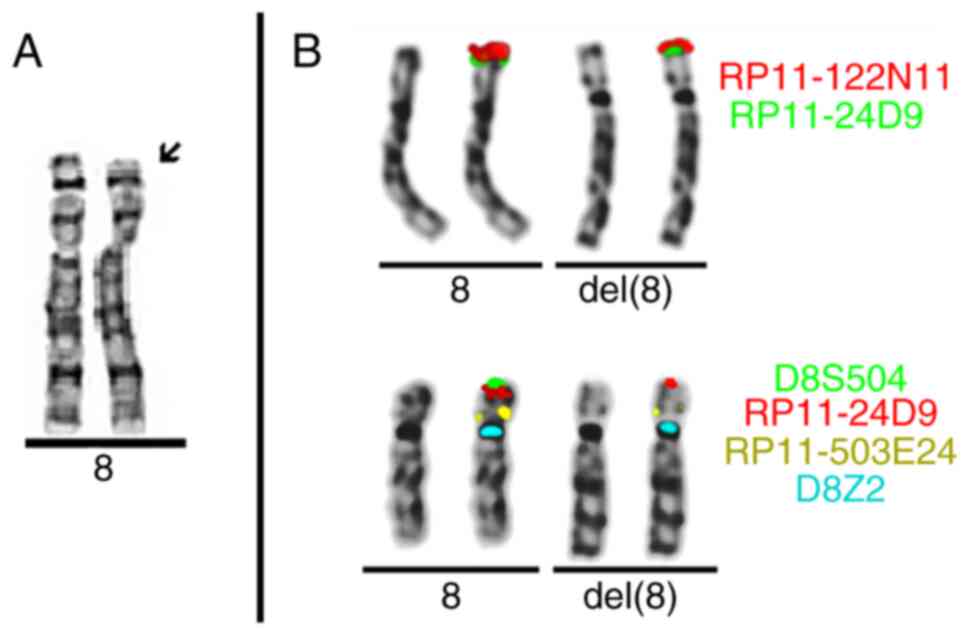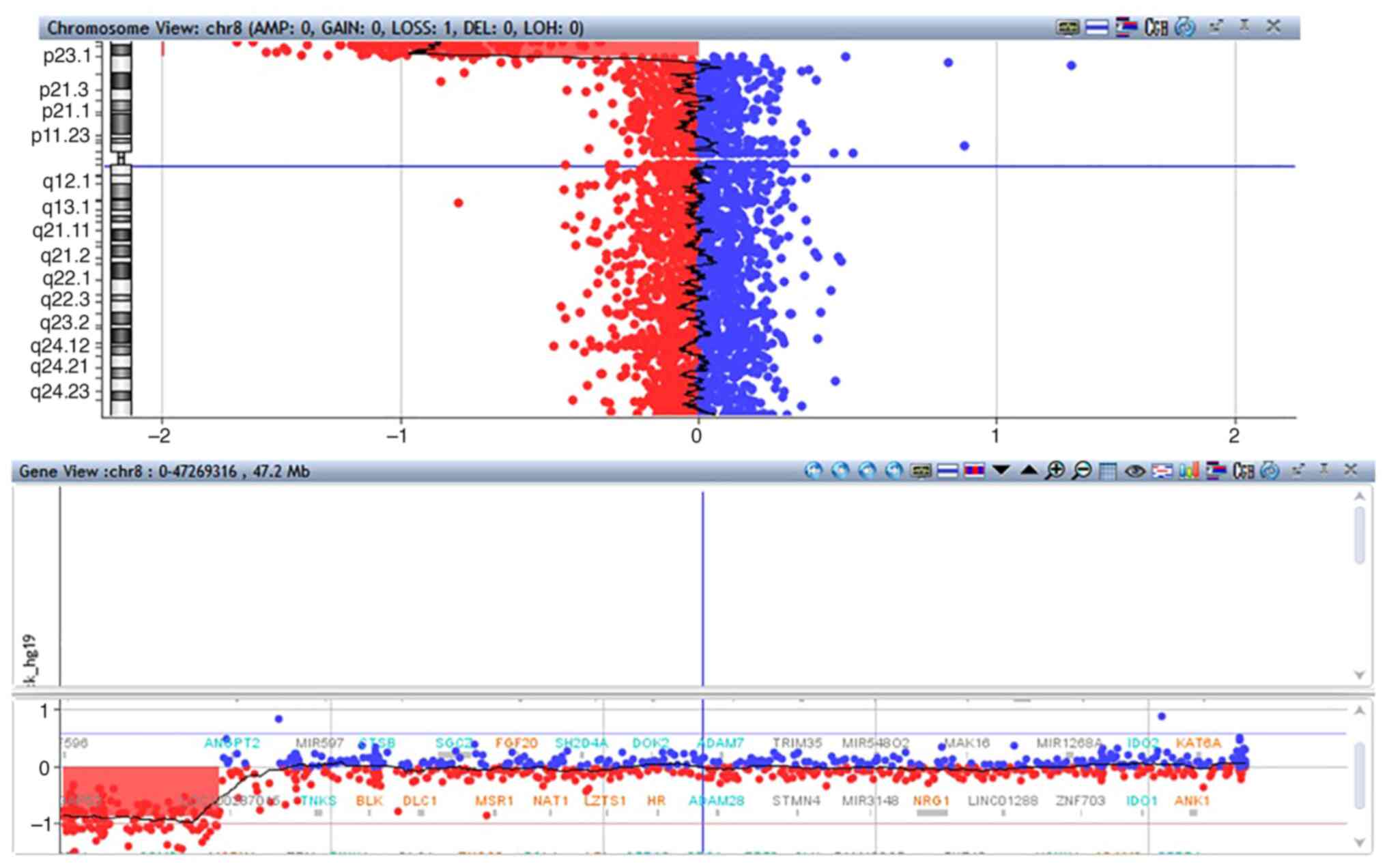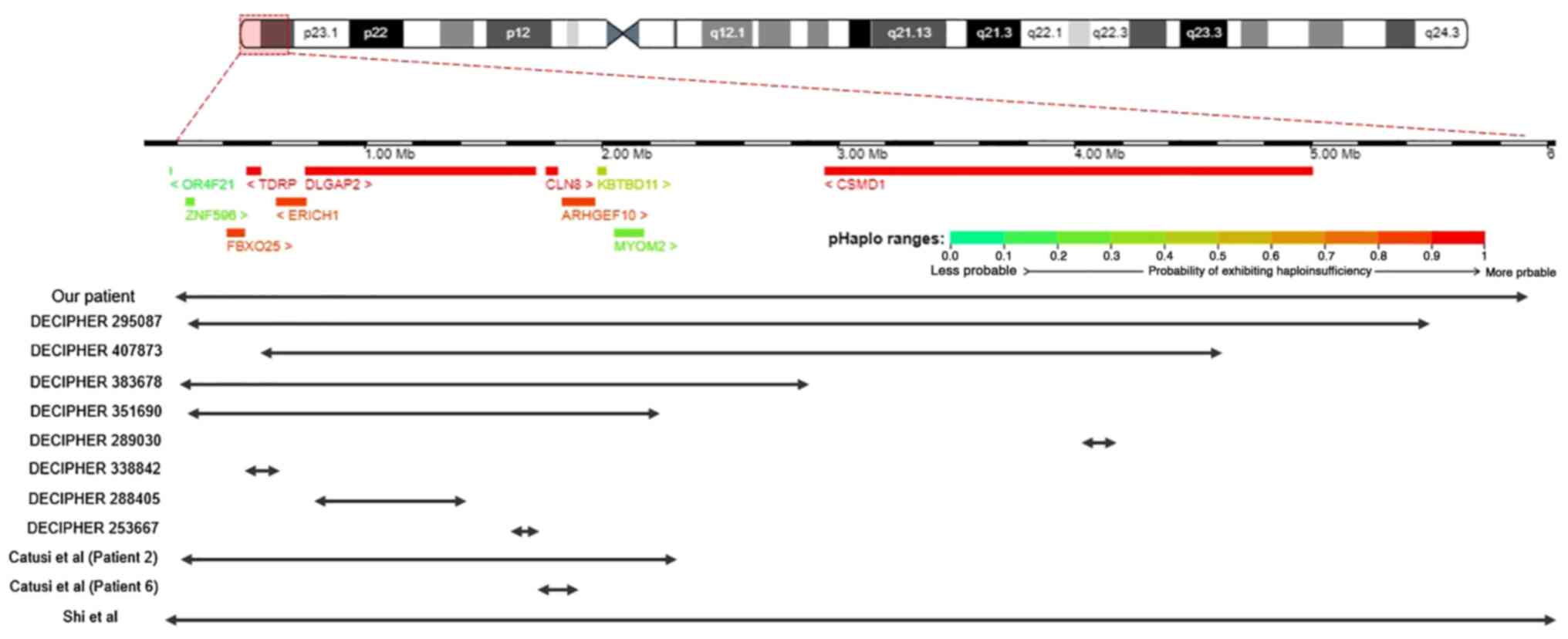An asymptomatic male individual carrying a 5.72 Mb de novo deletion in 8p23.2‑p23.3: A case report
- Authors:
- Published online on: April 3, 2024 https://doi.org/10.3892/etm.2024.12529
- Article Number: 241
Abstract
Introduction
Numerous rearrangements in the distal part of the short arm of chromosome 8 have previously been reported in the literature. This part of chromosome 8 is prone to a variety of rearrangements due to the existence of two olfactory receptor gene clusters, REPD (distal repeat) and REPP (proximal repeat), that flank a ~5 Mb region of 8p23.1. These rearrangements include, among others, the deletion or duplication of 8p23.1 between the two clusters, the 8p interstitial inverted duplication with associated terminal deletion (inv dup del(8p)) and the isolated terminal 8p23 deletion (1,2). There is a wide range of characteristics that are associated with such rearrangements. More specifically, deletions in 8p23 are associated with motor impairment, microcephaly, dysmorphism, epilepsy, growth and psychomotor delay, cardiac defects, hypotonia, facial anomalies, speech delay, attention deficit hyperactivity disorder, intellectual disability and seizures (2-6). However, the exact genotype-phenotype correlation regarding the 8p23 deletions still remains unknown. Deletions in 8p23.1 and gene GATA4 in particular have been identified to be responsible for heart defects in patients with 8p23 deletion (3,7,8). Additionally, it has been observed that the 8p23.2-p23.3 deletion usually leads to a milder phenotype (2,9). Herein, we describe a 30-year-old man that carries a de novo deletion in 8p23.2-p23.3 and is clinically asymptomatic.
Case report
The patient is a phenotypically normal 30-year-old man. His wife and him were referred to our lab due to the couple's two miscarriages. Physical examination as well as blood test were normal. Neurobehavioral testing and academic performance was normal. His height was 182 cm, his weight was 84 kg and his body mass index was 25.4 kg/m2.
Conventional karyotyping of the patient's blood T-lymphocytes was performed using high-resolution banding techniques. Twenty metaphases were analyzed following GTG banding. Conventional cytogenetic analysis of the patient's blood showed a deletion in 8p [karyotype according to ISCN was 46,XY,del(8)(p)]. Next, conventional cytogenetic analysis of the patient's parents followed to establish whether the deletion was inherited or if it occurred de novo. The parents had normal karyotypes (results not shown) indicating that the deletion occurred de novo in the patient. Lastly, cytogenetic analysis was performed in the patient's wife because of the couple's miscarriages. Her karyotype was also normal (data not shown).
Chromosome analysis on fixed blood cell suspension was performed (15 metaphases) using fluorescence in situ hybridization (FISH). Probes specific to genomic locations 8p23.1 (RP11-122N11, RP11-24D9, wcp 8), 8p23.3 (D8S504), 8p11.21 (RP11-503E24) and 8p11.1q11.1 (cep 8=D8Z2) were used. FISH analysis results suggested a terminal deletion in 8p23.3 [ish del(8)(p23.3)(wcp8+,D8S504-,RP11-122N11+,RP11-24D9+,RP11-503E24+,D8Z2+)] (Fig. 1).
High resolution molecular karyotyping was performed using an Array Comparative Genomic Hybridization (aCGH) platform of 60,000 oligonucleotides (Agilent technologies). DNA was extracted from the patient's whole blood cells and from embryonic tissue from the products of conception (POC) of the couple's second miscarriage using Promega Maxwell 16 and was hybridized with the human reference DNA of the same gender (Promega Biotech). The statistical test that was used as a parameter to estimate the number of copies was ADM-2 (provided by Agilent Technologies DNA analytics software) with a window of 0.5 Mb and a threshold of 6. Only those copy number changes that affected at least 5 consecutive probes with identically oriented change were considered as copy number variations. For most of the genome, the average analysis resolution was 200 kb. Molecular karyotyping of the patient's blood revealed a 5.721 Mb deletion in the 8p23.2-p23.3 region: arr[hg19] 8p23.3p23.2(191,530-5,912,296)x1 (Fig. 2). The deletion involves 25 genes, of which 10 are coding genes. More specifically, the coding genes located in the deleted area are ARHGEF10, CLN8, CSMD1, DLGAP2, ERICH1, FBXO25, KBTBD11, MYOM2, TDRP and ZNF596. All genes except for CSMD1 are located in 8p23.3 while CSMD1 is located in 8p23.2 (Fig. 3). All genes except for KBTBD11, MYOM2, and ZNF596 have a high probability of exhibiting haploinsufficiency (pHaplo scores are 0.80-0.96). Lastly, molecular karyotyping in the POC from the miscarriage indicated a normal male genomic profile of the fetus (data not shown).
Discussion
Numerous rearrangements in the distal part of chromosome 8p have been reported, including deletions in 8p23.1 and 8p23.2-pter. In this case report, we present the case of a man that is carrying a 5.72 Mb de novo deletion in 8p23.2-p23.3 that involves 10 coding genes, namely ZNF596, FBXO25, TDRP, ERICH1, DLGAP2, CLN8, ARHGEF10, KBTBD11, MYOM2 and CSMD1. The patient was diagnosed using conventional and molecular karyotyping as well as FISH analysis.
Rearrangements in this chromosomal area have been linked to a wide range of phenotypic characteristics that affect, among others, one's intellectual ability, motor skills, development, etc. The 8p23.2-p23.3 deletion has been associated with milder phenotypic characteristics (2,9). Interestingly, our patient remains completely asymptomatic. His clinical examination showed a normal male phenotype. Molecular karyotyping of the POC of the couple's miscarriage indicated a normal male genotype, suggesting that the miscarriage cannot be attributed to the 8p deletion our patient carries.
Due to the variability in phenotypic characteristics, we decided to compare reported cases of deletions similar to our patient's. In this comparison, we decided to only include patients that did not have any additional chromosomal abnormalities, since those could have an additive effect on the patients' phenotype. Searching in DECIPHER and the literature, we discovered patients that have similar deletions to our patient in the 8p23.2-p23.3 area that are summarized in Table I (Fig. 3). Patient 295087 and Patient 2 from Catusi et al (4) carry deletions (5.25 and 2.12 Mb respectively) that involve the same coding genes as our patient. Both these patients have an abnormal phenotype, with the first one having moderate intellectual disability and the second one presenting with a variety of symptoms including developmental delay and mobility issues. It is important to note that Patient 2 has inherited the deletion from his mother who is asymptomatic. Both Patient 2 and his mother also carry a microdeletion in 5p15.2. According to Catusi et al, this 5p microdeletion would probably be classified as likely benign but it could have an additive effect on the pathogenic phenotype (4). Another case of a similar deletion is DECIPHER patient 407873. He has a 4.37 Mb deletion in 8p23.2-23.3 that involves the same coding genes as our patient, except for ZNF596. His symptoms include abnormalities of the immune and nervous system. Another similar case is the patient from Shi et al who has a 5.85 Mb deletion in 8p23.2-8p23.3 that involves gene OR4F21 in addition to all other coding genes of our patient's deletion. This patient has mildly dysmorphic features, psychomotor delay, poor language and motor skills, attention deficit and others (2). The OR4F21 gene is an olfactory receptor gene and its deletion is most likely not responsible for the patient's symptoms (has a low probability of exhibiting haploinsufficiency). Next, DECIPHER patients 383678 and 351690 carry deletions (sizes 2.59 and 1.98 Mb respectively) that involve the same coding genes as our patient, except for CSMD1 which is located in 8p23.2. For patient 383678 no phenotype is included in DECIPHER, however, the deletion was classified as pathogenic. According to DECIPHER, patient 351690 has intellectual disability.
Table IData regarding our patient, 8 DECIPHER patients, 2 patients from Catusi et al (4) and the patient from Shi et al (2). |
Patients with smaller deletions in the 8p23.2-p23.3 region also present with symptoms. For instance, Patient 6 from Catusi et al has a 123 Kb deletion that only involves genes ARHGEF10 and CLN8. His symptoms involve epilepsy and scoliosis. Interestingly, his asymptomatic brother also carried the same deletion. Moreover, DECIPHER patient 289030, who has autism, has a 124.35 kb deletion in 8p23.2 that only involves the CSMD1 gene. Patient 338842 has a 28.72 kb deletion in 8p23.3 that only involves the TDRP gene and has abnormalities of the nervous system. Lastly, two DECIPHER patients, 288405 and 253667 have a 632.65 and 67.7 kb deletion respectively that only involve the DLGAP2 gene. Patient's 288405 symptoms include autism and intellectual disability while patient's 253667 symptoms include microcephaly and intellectual disability.
The exact genotype-phenotype correlation still remains unknown (2). Wu et al (10) suggested a critical region (CR) 2.05 Mb in size in 8p23.3 responsible for developmental delay, intellectual disability, microcephaly and neurobehavioral problems. This CR comprises of genes that have a role in neural differentiation and neural function (4,10). Genes ARHGEF10 (OMIM 608236), CLN8 (OMIM 607837), DLGAP2 (OMIM 605438) and CSMD1 (OMIM 608397) are associated to the central nervous system. ARHGEF10 (Rho guanine nucleotide exchange factor 10) encodes a Rho guanine nucleotide exchange factor that is thought to have a role in neural morphogenesis and connectivity. The ARHGEF10 protein has a role in developmental myelination of peripheral nerves (11). CLN8 (Ceroid lipofuscinosis, neuronal, 8) encodes a transmembrane protein that plays a role in lipid synthesis, transport and sensing. Mutations in this gene cause progressive epilepsy with intellectual disabilities (12,13). DLGAP2 (Discs large-associated protein 2) encodes a protein that is said to be involved in synapse scaling and is important for postsynaptic density. It is linked to a variety of neurological disorders including schizophrenia and the autism spectrum disease (14). CSMD1 (CUB and Sushi multiple domains 1) encodes a protein that is involved in brain circuits' development, signaling, neurotransmission etc. It is thought to be a regulator of complement activation and inflammation in the developing central nervous system and may play a role in nerve growth cone function (15,16).
As mentioned above, there is not a clear genotype-phenotype relationship established so far. Motor impairment has been linked to genes CLN8 and ARHGEF10 (4). Moreover, Shi et al hypothesized that the candidate genes responsible for developmental delay, intellectual disability, microcephaly and neurobehavioral disorders are DLGAP2, CLN8, ARHGEF10 and CSMD1 (2). In a recent genotype analysis performed by Catusi et al in order to narrow down the CR, the strongest candidate gene responsible for neurodevelopmental/behavioral phenotypes was DLGAP2 (4). Additionally, because of the asymptomatic mother of Patient 2 and brother of Patient 6, Catusi et al suggested that reduced penetrance should be further investigated and that more cases are needed in order to strengthen the hypothesis that incomplete penetrance of 8p23.2-pter deletions exists (4). Our case is in further support of the incomplete penetrance hypothesis of 8p23.2-p23.3 deletions.
Our patient, a carrier of a 5.72 Mb de novo deletion in 8p23.2-p23.3 that involves all genes that are in the critical region that is hypothesized to be responsible for the abnormal phenotypic traits in patients with such deletions, is a phenotypically normal male with no clinical symptoms. Other patients with similar deletions exhibit a variety of symptoms. This supports the hypothesis that there is incomplete penetrance of 8p23.2-p23.3 deletions.
Acknowledgements
Not applicable.
Funding
Funding: No funding was received.
Availability of data and materials
The datasets generated and/or analyzed during the current study are available in the ArrayExpress repository under accession no. E-MTAB-13528 (https://www.ebi.ac.uk/biostudies/arrayexpress/studies/E-MTAB-13528).
Authors' contributions
CK substantially contributed to the design of the work and prepared the manuscript. EM was in charge of overall patient management and project supervision, and critically revised the manuscript. IP performed and analyzed the molecular karyotype results and critically revised the manuscript. EPap was responsible for conventional cytogenetic analysis. TL performed the FISH experiment and interpreted the results. MBP significantly contributed to the design of the work and revised the manuscript. EPav, KK and AG were responsible for medical treatment and assessment of the patient and his wife. EM and IP confirm the authenticity of all the raw data. All authors read and approved the final manuscript.
Ethics approval and consent to participate
Not applicable.
Patient consent for publication
Written informed consent was obtained from the patient for publication of this case report and any accompanying images. Any information revealing the patient's identity was not included. All procedures followed were conducted according to The Declaration of Helsinki 1975, as revised in 2008.
Competing interests
The authors declare that they have no competing interests.
References
|
Yu S, Fiedler S, Stegner A and Graf WD: Genomic profile of copy number variants on the short arm of human chromosome 8. Eur J Hum Genet. 18:1114–1120. 2010.PubMed/NCBI View Article : Google Scholar | |
|
Shi S, Lin S, Chen B and Zhou Y: Isolated chromosome 8p23.2-pter deletion: Novel evidence for developmental delay, intellectual disability, microcephaly and neurobehavioral disorders. Mol Med Rep. 16:6837–6845. 2017.PubMed/NCBI View Article : Google Scholar | |
|
Páez MT, Yamamoto T, Hayashi K, Yasuda T, Harada N, Matsumoto N, Kurosawa K, Furutani Y, Asakawa S, Shimizu N and Matsuoka R: Two patients with atypical interstitial deletions of 8p23.1: Mapping of phenotypical traits. Am J Med Genet A. 146A:1158–1165. 2008.PubMed/NCBI View Article : Google Scholar | |
|
Catusi I, Garzo M, Capra AP, Briuglia S, Baldo C, Canevini MP, Cantone R, Elia F, Forzano F, Galesi O, et al: 8p23.2-pter microdeletions: Seven new cases narrowing the candidate region and review of the literature. Genes (Basel). 12(652)2021.PubMed/NCBI View Article : Google Scholar | |
|
de Die-Smulders CE, Engelen JJ, Schrander-Stumpel CT, Govaerts LC, de Vries B, Vles JS, Wagemans A, Schijns-Fleuren S, Gillessen-Kaesbach G and Fryns JP: Inversion duplication of the short arm of chromosome 8: Clinical data on seven patients and review of the literature. Am J Med Genet. 59:369–374. 1995.PubMed/NCBI View Article : Google Scholar | |
|
García-Santiago FA, Martínez-Glez V, Santos F, García-Miñaur S, Mansilla E, Meneses AG, Rosell J, Granero ÁP, Vallespín E, Fernández L, et al: Analysis of invdupdel(8p) rearrangement: Clinical, cytogenetic and molecular characterization. Am J Med Genet A. 167A:1018–1025. 2015.PubMed/NCBI View Article : Google Scholar | |
|
Wat MJ, Shchelochkov OA, Holder AM, Breman AM, Dagli A, Bacino C, Scaglia F, Zori RT, Cheung SW, Scott DA and Kang SH: Chromosome 8p23.1 deletions as a cause of complex congenital heart defects and diaphragmatic hernia. Am J Med Genet A. 149A:1661–1677. 2009.PubMed/NCBI View Article : Google Scholar | |
|
Ballarati L, Cereda A, Caselli R, Selicorni A, Recalcati MP, Maitz S, Finelli P, Larizza L and Giardino D: Genotype-phenotype correlations in a new case of 8p23.1 deletion and review of the literature. Eur J Med Genet. 54:55–59. 2011.PubMed/NCBI View Article : Google Scholar | |
|
Burnside RD, Pappas JG, Sacharow S, Applegate C, Hamosh A, Gadi IK, Jaswaney V, Keitges E, Phillips KK, Potluri VR, et al: Three cases of isolated terminal deletion of chromosome 8p without heart defects presenting with a mild phenotype. Am J Med Genet A. 161A:822–828. 2013.PubMed/NCBI View Article : Google Scholar | |
|
Wu Y, Ji T, Wang J, Xiao J, Wang H, Li J, Gao Z, Yang Y, Cai B, Wang L, et al: Submicroscopic subtelomeric aberrations in Chinese patients with unexplained developmental delay/mental retardation. BMC Med Genet. 11(72)2010.PubMed/NCBI View Article : Google Scholar | |
|
Verhoeven K, De Jonghe P, Van de Putte T, Nelis E, Zwijsen A, Verpoorten N, De Vriendt E, Jacobs A, Van Gerwen V, Francis A, et al: Slowed conduction and thin myelination of peripheral nerves associated with mutant rho guanine-nucleotide exchange factor 10. Am J Hum Genet. 73:926–932. 2003.PubMed/NCBI View Article : Google Scholar | |
|
Mole SE, Williams RE and Goebel HH: Correlations between genotype, ultrastructural morphology and clinical phenotype in the neuronal ceroid lipofuscinoses. Neurogenetics. 6:107–126. 2005.PubMed/NCBI View Article : Google Scholar | |
|
Passantino R, Cascio C, Deidda I, Galizzi G, Russo D, Spedale G and Guarneri P: Identifying protein partners of CLN8, an ER-resident protein involved in neuronal ceroid lipofuscinosis. Biochim Biophys Acta. 1833:529–540. 2013.PubMed/NCBI View Article : Google Scholar | |
|
Rasmussen AH, Rasmussen HB and Silahtaroglu A: The DLGAP family: Neuronal expression, function and role in brain disorders. Mol Brain. 10(43)2017.PubMed/NCBI View Article : Google Scholar | |
|
Kraus DM, Elliott GS, Chute H, Horan T, Pfenninger KH, Sanford SD, Foster S, Scully S, Welcher AA and Holers VM: CSMD1 is a novel multiple domain complement-regulatory protein highly expressed in the central nervous system and epithelial tissues. J Immunol. 176:4419–4430. 2006.PubMed/NCBI View Article : Google Scholar | |
|
Gayed EMAE, Rizk MS, Ramadan AN and Bayomy NR: mRNA expression of the CUB and sushi multiple domains 1 (CSMD1) and its serum protein level as predictors for psychosis in the familial high-risk children and young adults. ACS Omega. 6(24128)2021.PubMed/NCBI View Article : Google Scholar |












